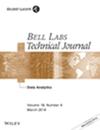下载PDF
{"title":"Making Smart Use of Excess Antennas: Massive MIMO, Small Cells, and TDD","authors":"Jakob Hoydis, Kianoush Hosseini, Stephan ten Brink, Mérouane Debbah","doi":"10.1002/bltj.21602","DOIUrl":null,"url":null,"abstract":"<p>In this paper, we present a vision beyond the conventional Long Term Evolution Fourth Generation (LTE-4G) evolution path and suggest that time division duplexing (TDD) could be a key enabler for a new heterogeneous network architecture with the potential to provide ubiquitous coverage and unprecedented spectral area efficiencies. This architecture is based on a co-channel deployment of macro base stations (BSs) with very large antenna arrays and a secondary tier of small cells (SCs) with a few antennas each. Both tiers employ a TDD protocol in a synchronized fashion. The resulting channel reciprocity enables not only the estimation of large-dimensional channels at the BSs, but also an implicit coordination between both tiers without the need to exchange user data or channel state information (CSI) over the backhaul. In particular, during the uplink (UL), the BSs and SCs can locally estimate the dominant interference sub-space. This knowledge can be leveraged for downlink (DL) precoding to reduce intra- and inter-tier interference. In other words, the BSs and SCs “sacrifice” some of their degrees of freedom for interference rejection. Our simulation results demonstrate that the proposed architecture and precoding scheme can achieve a very attractive rate region compared to several baseline scenarios. For example, with 100 antennas at each BS and four antennas at each SC, we observe an aggregate area throughput of 7.63 Gb/s/km<sup>2</sup> (DL) and 8.93 Gb/s/km<sup>2</sup> (UL) on a 20 MHz band shared by about 100 mobile devices. © 2013 Alcatel-Lucent.</p>","PeriodicalId":55592,"journal":{"name":"Bell Labs Technical Journal","volume":"18 2","pages":"5-21"},"PeriodicalIF":0.0000,"publicationDate":"2013-08-28","publicationTypes":"Journal Article","fieldsOfStudy":null,"isOpenAccess":false,"openAccessPdf":"https://sci-hub-pdf.com/10.1002/bltj.21602","citationCount":"206","resultStr":null,"platform":"Semanticscholar","paperid":null,"PeriodicalName":"Bell Labs Technical Journal","FirstCategoryId":"1085","ListUrlMain":"https://onlinelibrary.wiley.com/doi/10.1002/bltj.21602","RegionNum":0,"RegionCategory":null,"ArticlePicture":[],"TitleCN":null,"AbstractTextCN":null,"PMCID":null,"EPubDate":"","PubModel":"","JCR":"Q1","JCRName":"Engineering","Score":null,"Total":0}
引用次数: 206
引用
批量引用
Abstract
In this paper, we present a vision beyond the conventional Long Term Evolution Fourth Generation (LTE-4G) evolution path and suggest that time division duplexing (TDD) could be a key enabler for a new heterogeneous network architecture with the potential to provide ubiquitous coverage and unprecedented spectral area efficiencies. This architecture is based on a co-channel deployment of macro base stations (BSs) with very large antenna arrays and a secondary tier of small cells (SCs) with a few antennas each. Both tiers employ a TDD protocol in a synchronized fashion. The resulting channel reciprocity enables not only the estimation of large-dimensional channels at the BSs, but also an implicit coordination between both tiers without the need to exchange user data or channel state information (CSI) over the backhaul. In particular, during the uplink (UL), the BSs and SCs can locally estimate the dominant interference sub-space. This knowledge can be leveraged for downlink (DL) precoding to reduce intra- and inter-tier interference. In other words, the BSs and SCs “sacrifice” some of their degrees of freedom for interference rejection. Our simulation results demonstrate that the proposed architecture and precoding scheme can achieve a very attractive rate region compared to several baseline scenarios. For example, with 100 antennas at each BS and four antennas at each SC, we observe an aggregate area throughput of 7.63 Gb/s/km2 (DL) and 8.93 Gb/s/km2 (UL) on a 20 MHz band shared by about 100 mobile devices. © 2013 Alcatel-Lucent.
智能利用多余天线:大规模MIMO、小型蜂窝和TDD
在本文中,我们提出了一种超越传统长期演进第四代(LTE-4G)演进路径的愿景,并提出时分双工(TDD)可能是一种新的异构网络架构的关键推动者,该架构有可能提供无处不在的覆盖和前所未有的频谱区域效率。该架构基于宏基站(BS)的同信道部署,宏基站具有非常大的天线阵列,而小小区(SC)的次级层各具有几个天线。这两层都以同步的方式使用TDD协议。所得到的信道互易性不仅能够估计BS处的大维信道,而且能够在两个层之间进行隐式协调,而不需要在回程上交换用户数据或信道状态信息(CSI)。特别地,在上行链路(UL)期间,BS和SC可以本地估计主要干扰子空间。此知识可用于下行链路(DL)预编码以减少层内和层间干扰。换言之,BS和SC为了拒绝干扰而“牺牲”了一些自由度。我们的仿真结果表明,与几种基线场景相比,所提出的架构和预编码方案可以实现非常有吸引力的速率区域。例如,在每个BS处有100个天线,在每个SC处有4个天线的情况下,我们在大约100个移动设备共享的20MHz频带上观察到7.63 Gb/s/km2(DL)和8.93 Gb/s/平方公里(UL)的总区域吞吐量。
本文章由计算机程序翻译,如有差异,请以英文原文为准。


